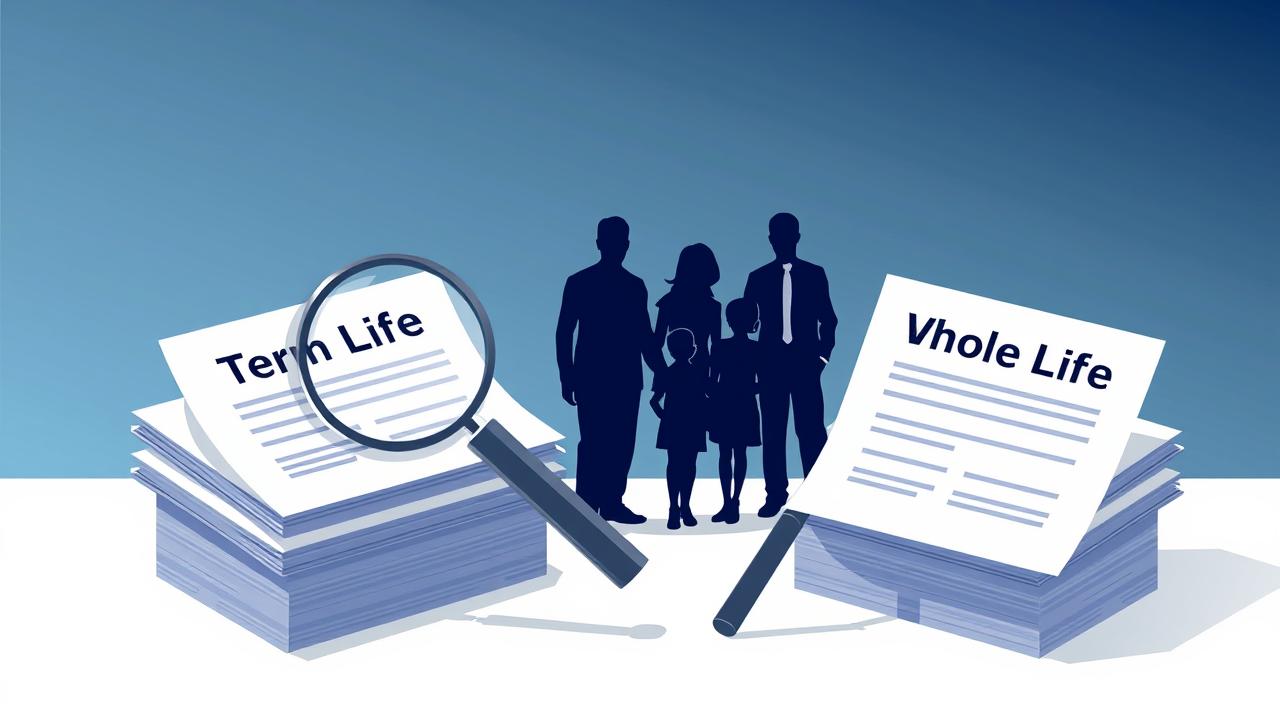Term Life vs Whole Life Insurance: Pros and Cons
When it comes to protecting loved ones and securing financial futures, understanding the differences between Term Life Insurance and Whole Life Insurance is essential. Each type of life insurance policy offers unique advantages and disadvantages, catering to varied financial objectives and needs. While term life insurance is typically characterized by its short-term coverage at lower premiums, whole life insurance provides lifelong protection and accumulates cash value over time. In this article, we will delve into the pros and cons of each policy, helping you make an informed decision about which option is best for you.
Key Takeaways
- Term Life Insurance offers lower premiums and is suitable for temporary needs.
- Whole Life Insurance provides lifelong coverage with a cash value component.
- Consider personal financial goals when choosing between Term Life Insurance and Whole Life Insurance.
- Both options come with distinct pros and cons that need thorough evaluation.
- Understanding the duration and premium structure is crucial in making the right choice.
Understanding Term Life Insurance
Term life insurance offers a simple approach to life coverage, making it a popular choice for individuals seeking straightforward protection. As the name suggests, this insurance type provides coverage for a specified duration, allowing policyholders to secure financial protection for their loved ones during critical years.
Definition and Features
The definition and features of term life insurance highlight its intended purpose. This insurance covers the insured for a predetermined term, often ranging from 10 to 30 years. It provides a death benefit to beneficiaries if the insured passes away during this period. Importantly, term life insurance does not include a cash value component, differentiating it from whole life policies.
Duration and Coverage
Duration and coverage are key factors when considering term life insurance. Policies are customizable, accommodating various timelines and amounts of coverage. Individuals can select terms that align with financial responsibilities, such as home mortgages or children’s educational needs. This enables policyholders to match their coverage duration to their specific situations, ensuring adequate protection.
Affordability Factor
The affordability factor serves as one of the standout benefits of term life insurance. Premiums for term policies are generally much lower than those for whole life products, making them accessible for many. For example, a healthy 40-year-old male might secure a 30-year term at an average monthly premium of just $27. This affordability allows families to obtain necessary coverage without straining budgets.
Exploring Whole Life Insurance
Whole life insurance serves as a robust financial tool designed to offer lifelong coverage. This type of insurance attracts attention due to its various key characteristics that distinguish it from other types of policies. Understanding these elements is crucial for anyone considering a long-term financial strategy.
Key Characteristics
The most notable key characteristics of whole life insurance include guaranteed death benefits and fixed premiums. As long as you continue to pay the premiums, your beneficiaries will receive a payout upon your passing. This assurance makes whole life insurance a stable choice for individuals aiming for consistent financial planning.
Cash Value Component
Another essential aspect is the cash value component. This feature allows the policy to accumulate cash value over time, which grows at a guaranteed rate. Policyholders may take loans against this cash value, offering a fluid asset that can assist with unexpected expenses or serve as an investment opportunity. Such functionality transforms whole life insurance into a multifaceted financial resource.
Premium Structure
The premium structure of whole life insurance differs significantly from term life insurance. Whole life policies typically require higher premiums because they encompass lifetime coverage alongside the cash value accumulation. These premiums remain fixed, creating an element of predictability for financial planning. For individuals looking for lifetime security, this structured approach offers peace of mind and stability.
By investing in whole life insurance, you not only secure a financial safety net for your loved ones but also engage in a wealth accumulation strategy. This dual functionality may well align with your long-term financial aspirations, making it a viable choice in today’s market. For those interested in broader financial strategies, explore more about smart home decor investments and how they may complement your overall financial planning.
Pros of Term Life Insurance
When considering life insurance options, many find that term life insurance provides distinct advantages. This type of policy offers significant savings and straightforward coverage, making it particularly appealing for a variety of needs.
Lower Premium Costs
One of the most compelling Term Life Insurance Benefits is the lower premium costs. Compared to whole life insurance, term policies usually come at a fraction of the price, allowing individuals to secure essential coverage without straining their finances. This affordability enables policyholders to allocate their resources effectively, ensuring peace of mind without compromising other financial obligations.
Simplicity in Coverage
Another advantage is the simplicity in coverage. Term life insurance typically features clear terms and conditions, making it easier for individuals to understand the policy. Policyholders can choose a coverage period that fits their situation best, such as 10, 20, or 30 years. In the unfortunate event of death during the policy term, beneficiaries receive a straightforward payout without complications, making the process seamless during challenging times.
Ideal for Temporary Needs
Term life insurance is particularly ideal for temporary needs. Many people acquire this type of policy to cover financial responsibilities that will diminish over time, such as raising children or paying off a mortgage. By selecting a term that aligns with these obligations, individuals can ensure that loved ones are financially protected without committing to lifelong premiums.

Pros of Whole Life Insurance
Whole life insurance presents several compelling advantages, making it a popular choice among individuals seeking long-term security. One of the primary benefits is the commitment to lifelong coverage, which offers peace of mind for policyholders and their loved ones.
Lifelong Coverage
With whole life insurance, policyholders enjoy perpetual protection as long as they adhere to the premium payments. This lifelong coverage ensures that no matter when an individual passes away, their beneficiaries receive the intended death benefit. Unlike term life insurance, where policies expire after a set duration, whole life policies provide lasting security.
Cash Value Accumulation
Another significant advantage lies in cash value accumulation. Over time, a portion of the premiums is invested, allowing the policy to build a cash value that grows tax-deferred. Policyholders can access these funds if needed, providing financial flexibility for emergencies, education costs, or other expenses. Such features contribute to the overall financial strategy for many, enhancing the appeal of whole life insurance.
Potential Dividends
Certain whole life policies may qualify for potential dividends, providing an additional source of benefits. These dividends result from the insurer’s financial performance and can be used to increase the policy’s cash value or even reduce the premium payments. Such opportunities augment the whole life insurance advantages, making it a financial instrument that grows more valuable over time.

Cons of Term Life Insurance
While term life insurance presents many benefits, it carries several Term Life Insurance Disadvantages that potential policyholders should consider. Understanding these drawbacks can help individuals make informed decisions about their insurance needs.
No Cash Value Build-up
One of the most significant drawbacks of term life insurance is the No Cash Value Build-up. Unlike whole life insurance, term policies do not accumulate any savings or cash value. As policyholders pay their premiums, they receive coverage without the benefit of building equity for future use.
Coverage Expiration
Individuals must also be aware of Coverage Expiration. Term life policies provide coverage only for a specified duration, after which the policy ends without providing any financial return. This expiration can leave policyholders unprotected if they still have dependents or other financial obligations at that time.
Possible Premium Increases
Moreover, there are Possible Premium Increases upon renewal or purchasing a new term policy. As individuals age or if their health changes, the cost of premiums can rise significantly. This increase may diminish the affordability that attracted them to term life insurance in the first place.
Cons of Whole Life Insurance
While whole life insurance offers benefits, it is crucial to consider the Whole Life Insurance Drawbacks that come with this type of policy. One of the most significant cons is the Higher Premiums associated with whole life insurance compared to term life options. Families or individuals with tight budgets may find these costs challenging to accommodate, especially when balancing multiple financial responsibilities.
Moreover, the Complexity in Understanding whole life policies can be daunting. Consumers often struggle with the intricacies of cash value accumulation, dividend distributions, and potential loan options. This complexity may require seeking professional advice, adding another layer of expense and complication to the decision-making process.
Last but not least, there is the issue of Less Flexibility in Adjustments. Once enrolled in a whole life policy, making changes can be cumbersome compared to term life insurance. The integration of savings components and long-term commitments can limit options for consumers whose financial circumstances evolve over time, potentially leading to dissatisfaction or financial strain.






